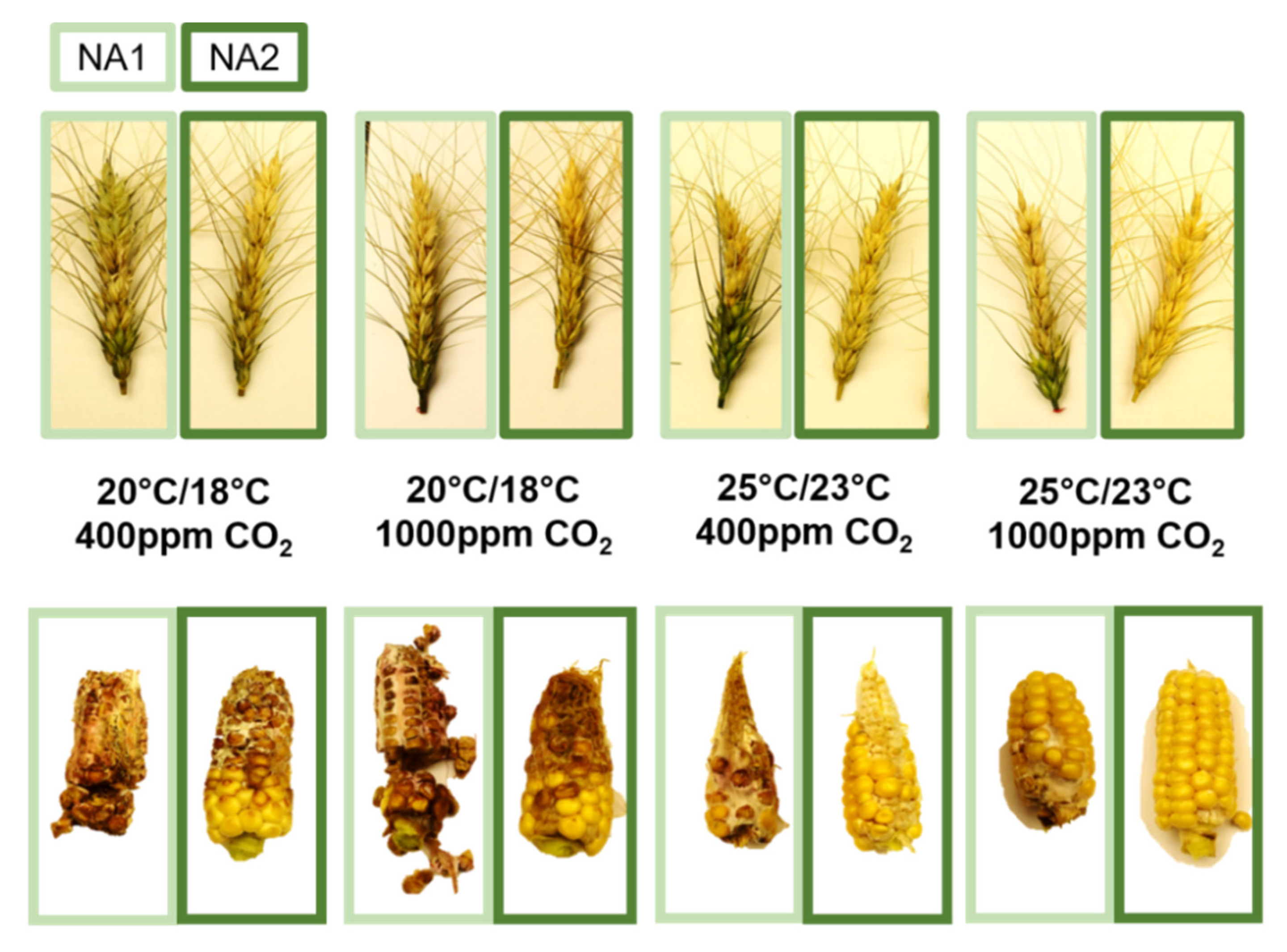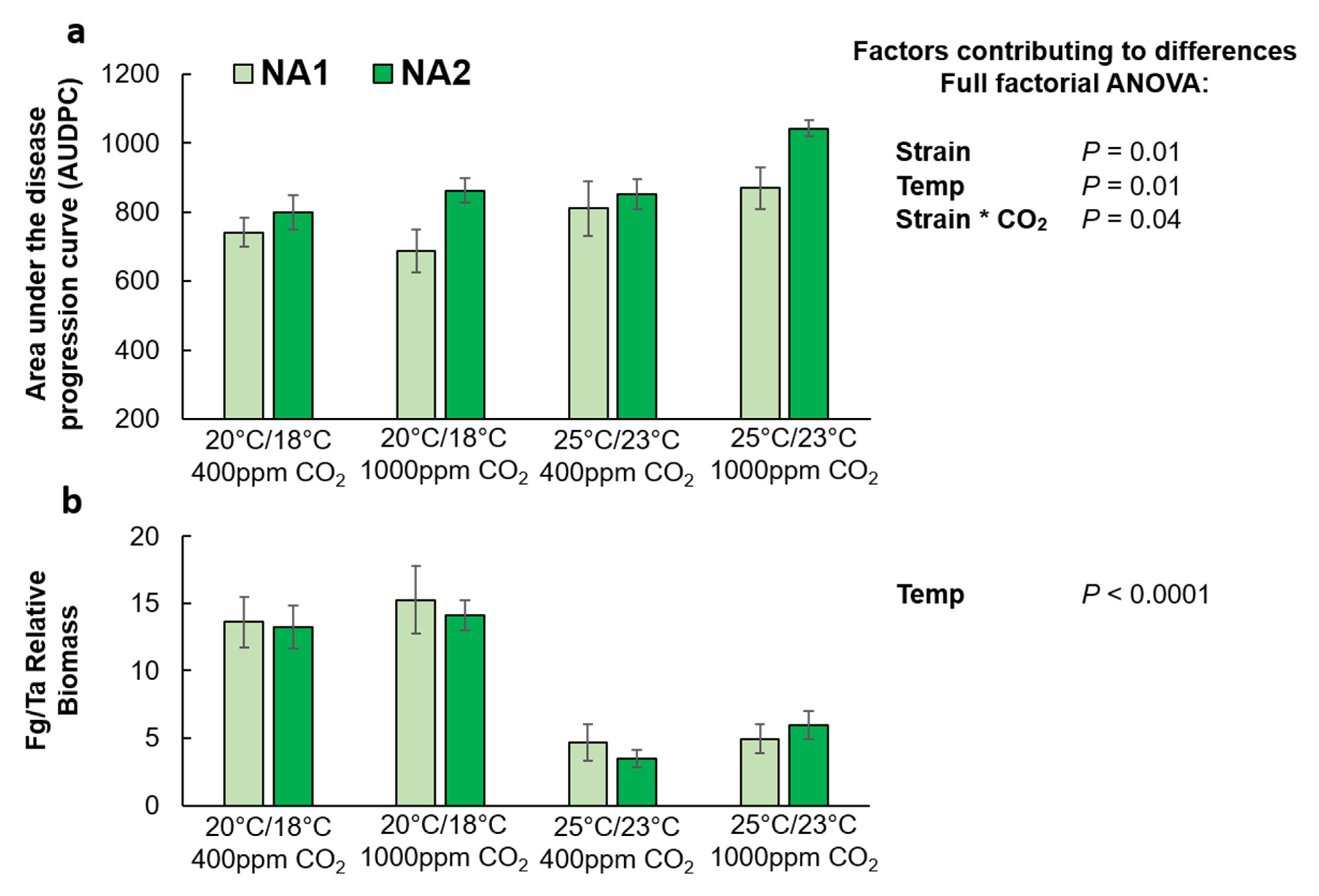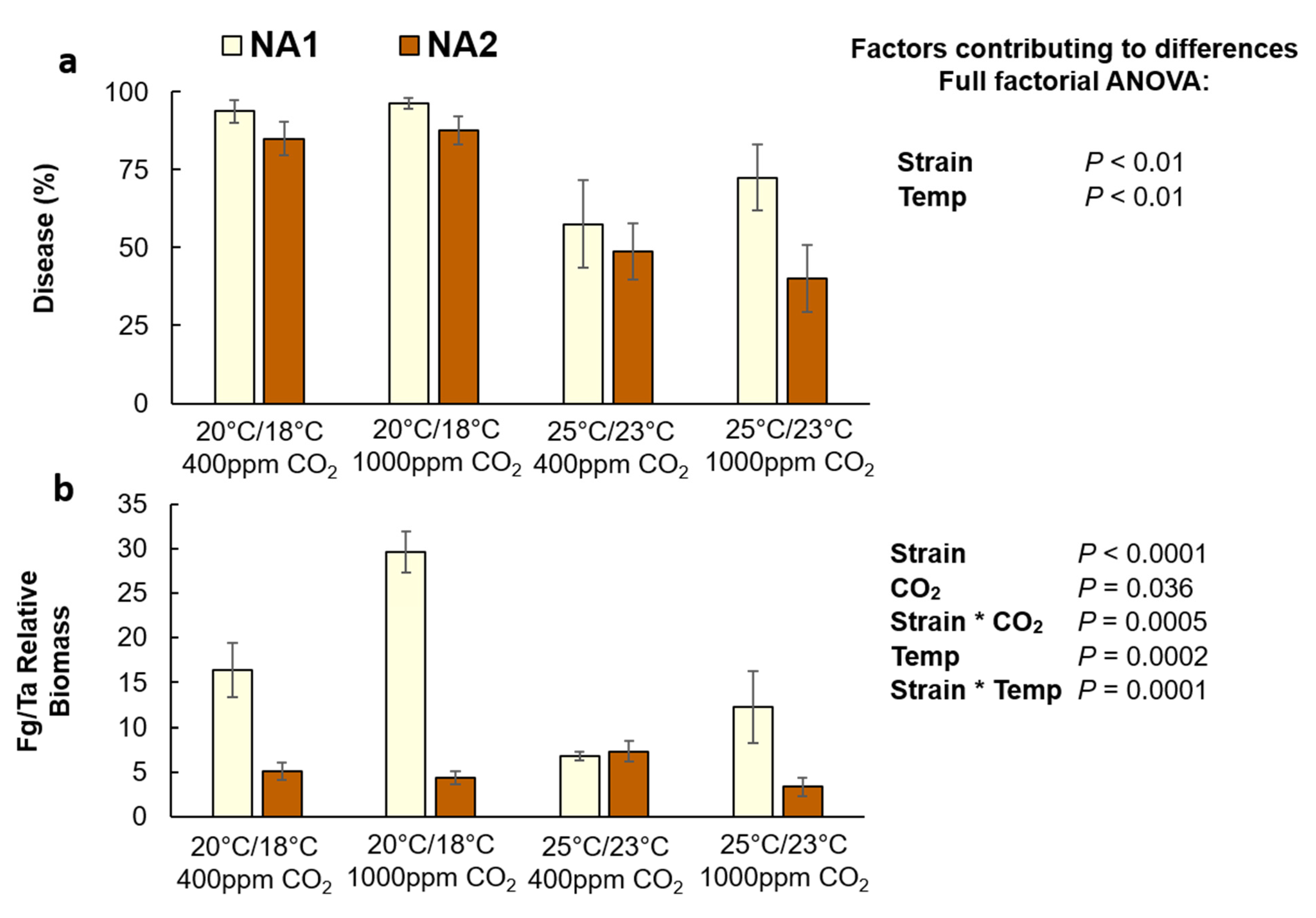Effects of Atmospheric CO2 and Temperature on Wheat and Corn Susceptibility to Fusarium graminearum and Deoxynivalenol Contamination
Abstract
:1. Introduction
2. Results
2.1. Effects of Elevated CO2 and Temperature on F. graminearum Disease Severity in Wheat
2.2. Effects of Elevated CO2 and Temperature on F. graminearum Disease Severity in Corn
3. Discussion
4. Materials and Methods
4.1. Wheat and Corn Cultivars and Growth Conditions
4.2. Inoculations and Disease Evaluation
4.3. Mycotoxin Analyses
4.4. Estimation of Host and Pathogen Biomass
4.5. Statistical Analyses
5. Conclusions
Supplementary Materials
Author Contributions
Funding
Institutional Review Board Statement
Informed Consent Statement
Data Availability Statement
Acknowledgments
Conflicts of Interest
References
- O’Donnell, K.; Ward, T.J.; Geiser, D.M.; Kistler, H.; Aoki, T. Genealogical concordance between the mating type locus and seven other nuclear genes supports formal recognition of nine phylogenetically distinct species within the Fusarium graminearum clade. Fungal Genet. Biol. 2004, 41, 600–623. [Google Scholar] [CrossRef] [PubMed]
- Goswami, R.S.; Kistler, H. Heading for disaster: Fusarium graminearum on cereal crops. Mol. Plant Pathol. 2004, 5, 515–525. [Google Scholar] [CrossRef] [PubMed]
- Awad, W.A.; Ghareeb, K.; Dadak, A.; Hess, M.; Böhm, J. Single and Combined Effects of Deoxynivalenol Mycotoxin and a Microbial Feed Additive on Lymphocyte DNA Damage and Oxidative Stress in Broiler Chickens. PLoS ONE 2014, 9, e88028. [Google Scholar] [CrossRef] [PubMed]
- Bullerman, L.B.; Bianchini, A. Stability of mycotoxins during food processing. Int. J. Food Microbiol. 2007, 119, 140–146. [Google Scholar] [CrossRef]
- Mastanjević, K.; Lukinac, J.; Jukić, M.; Šarkanj, B.; Krstanović, V.; Mastanjević, K. Multi-(myco) toxins in malting and brewing by-products. Toxins 2019, 11, 30. [Google Scholar] [CrossRef] [Green Version]
- Wilson, W.; Dahl, B.; Nganje, W. Economic costs of Fusarium Head Blight, scab and deoxynivalenol. World Mycotoxin J. 2018, 11, 291–302. [Google Scholar] [CrossRef]
- Mueller, D.S.; Wise, K.A.; Sisson, A.J.; Allen, T.W.; Bergstrom, G.C.; Bosley, D.B.; Bradley, C.A.; Broders, K.D.; Byamukama, E.; Chilvers, M.I.; et al. Corn Yield Loss Estimates Due to Diseases in the United States and Ontario, Canada from 2012 to 2015. Plant Health Prog. 2016, 17, 211–222. [Google Scholar] [CrossRef] [Green Version]
- Vaughan, M.; Backhouse, D.; Del Ponte, E. Climate change impacts on the ecology of Fusarium graminearum species complex and susceptibility of wheat to Fusarium head blight: A review. World Mycotoxin J. 2016, 9, 685–700. [Google Scholar] [CrossRef] [Green Version]
- Chakraborty, S. Migrate or evolve: Options for plant pathogens under climate change. Glob. Chang. Biol. 2013, 19, 1985–2000. [Google Scholar] [CrossRef]
- Brown, N.A.; Urban, M.; van de Meene, A.M.L.; Hammond-Kosack, K.E. The infection biology of Fusarium graminearum: Defining the pathways of spikelet to spikelet colonisation in wheat ears. Fungal Biol. 2010, 114, 555–571. [Google Scholar] [CrossRef]
- Martins, M.L.G.; Martins, H.M. Influence of water activity, temperature and incubation time on the simultaneous production of deoxynivalenol and zearalenone in corn (Zea mays) by Fusarium graminearum. Food Chem. 2002, 79, 315–318. [Google Scholar] [CrossRef]
- Ramirez, M.L.; Chulze, S.; Magan, N. Temperature and water activity effects on growth and temporal deoxynivalenol production by two Argentinean strains of Fusarium graminearum on irradiated wheat grain. Int. J. Food Microbiol. 2006, 106, 291–296. [Google Scholar] [CrossRef] [PubMed]
- Kuhnem, P.R.; Del Ponte, E.M.; Dong, Y.; Bergstrom, G.C. Fusarium graminearum isolates from wheat and maize in New York show similar range of aggressiveness and toxigenicity in cross-species pathogenicity tests. Phytopathology 2015, 105, 441–448. [Google Scholar] [CrossRef] [Green Version]
- Guo, H.; Ji, J.; Wang, J.; Sun, X. Deoxynivalenol: Masked forms, fate during food processing, and potential biological remedies. Compr. Rev. Food Sci. Food Saf. 2020, 19, 895–926. [Google Scholar] [CrossRef] [Green Version]
- Ward, T.J.; Clear, R.M.; Rooney, A.; O’Donnell, K.; Gaba, D.; Patrick, S.; Starkey, D.E.; Gilbert, J.; Geiser, D.M.; Nowicki, T.W. An adaptive evolutionary shift in Fusarium head blight pathogen populations is driving the rapid spread of more toxigenic Fusarium graminearum in North America. Fungal Genet. Biol. 2008, 45, 473–484. [Google Scholar] [CrossRef] [PubMed]
- Váry, Z.; Mullins, E.; McElwain, G.C.; Doohan, F.M. The severity of wheat diseases increases when plants and pathogens are acclimatized to elevated carbon dioxide. Glob. Chang. Biol. 2015, 21, 2661–2669. [Google Scholar] [CrossRef]
- Hay, W.T.; McCormick, S.P.; Hojilla-Evangelista, M.P.; Bowman, M.J.; Dunn, R.O.; Teresi, J.M.; Berhow, M.A.; Vaughan, M.M. Changes in wheat nutritional content at elevated [CO2] alter Fusarium graminearum growth and mycotoxin production on grain. J. Agric. Food Chem. 2020, 68, 6297–6307. [Google Scholar] [CrossRef]
- Medina, Á.; Rodríguez, A.; Magan, N. Climate change and mycotoxigenic fungi: Impacts on mycotoxin production. Curr. Opin. Food Sci. 2015, 5, 99–104. [Google Scholar] [CrossRef]
- Cuperlovic-Culf, M.; Vaughan, M.M.; Vermillion, K.; Surendra, A.; Teresi, J.; McCormick, S. Effects of Atmospheric CO2 Level on the Metabolic Response of Resistant and Susceptible Wheat to Fusarium graminearum Infection. Mol. Plant-Microbe Interactions 2019, 32, 379–391. [Google Scholar] [CrossRef] [Green Version]
- Bencze, S.; Puskás, K.; Vida, G.; Karsai, I.; Balla, K.; Komáromi, J.; Veisz, O. Rising atmospheric CO2 concentration may imply higher risk of Fusarium mycotoxin contamination of wheat grains. Mycotoxin Res. 2017, 33, 229–236. [Google Scholar] [CrossRef]
- Ainsworth, E.A.; Long, S.P. 30 years of free-air carbon dioxide enrichment (FACE): What have we learned about future crop productivity and its potential for adaptation? Glob. Chang. Biol. 2020, 27, 27–49. [Google Scholar] [CrossRef]
- Farquhar, G.D.; Von Caemmerer, S.; Berry, J.A. A biochemical model of photosynthetic CO2 assimilation in leaves of C3 species. Planta 1980, 149, 78–90. [Google Scholar] [CrossRef] [Green Version]
- Ehleringer, J.R.; Cerling, T.E.; Helliker, B.R. C 4 photosynthesis, atmospheric CO2, and climate. Oecologia 1997, 112, 285–299. [Google Scholar] [CrossRef] [PubMed]
- Sage, R.F.; Sage, T.L.; Kocacinar, F. Photorespiration and the Evolution of C4 Photosynthesis. Annu. Rev. Plant Biol. 2012, 63, 19–47. [Google Scholar] [CrossRef]
- Liang, J.M.; Xayamongkhon, H.; Broz, K.; Dong, Y.; McCormick, S.P.; Abramova, S.; Ward, T.J.; Ma, Z.H.; Kistler, H.C. Temporal dynamics and population genetic structure of Fusarium graminearum in the upper Midwestern United States. Fungal Genet. Biol. 2014, 73, 83–92. [Google Scholar] [CrossRef] [PubMed]
- Alexander, N.J.; McCormick, S.P.; Waalwijk, C.; van der Lee, T.; Proctor, R.H. The genetic basis for 3-ADON and 15-ADON trichothecene chemotypes in Fusarium. Fungal Genet. Biol. 2011, 48, 485–495. [Google Scholar] [CrossRef] [Green Version]
- Mackintosh, C.A.; Garvin, D.F.; Radmer, L.E.; Heinen, S.J.; Muehlbauer, G.J. A model wheat cultivar for transformation to improve resistance to Fusarium Head Blight. Plant Cell Rep. 2006, 25, 313–319. [Google Scholar] [CrossRef]
- Bugbee, B.; Koerner, G.; Albrechtsen, R.; Dewey, W.; Clawson, S. Registration of ‘USU-Apogee’ wheat. Crop. Sci. 1997, 37, 626. [Google Scholar] [CrossRef]
- Desjardins, A.E.; Busman, M.; Manandhar, G.; Jarosz, A.M.; Manandhar, H.K.; Proctor, R.H. Gibberella ear rot of maize (Zea mays) in Nepal: Distribution of the mycotoxins nivalenol and deoxynivalenol in naturally and experimentally infected maize. J. Agric. Food Chem. 2008, 56, 5428–5436. [Google Scholar] [CrossRef]
- Asseng, S.; Martre, P.; Maiorano, A.; Rötter, R.P.; O’Leary, G.J.; Fitzgerald, G.J.; Girousse, C.; Motzo, R.; Giunta, F.; Babar, M.A.; et al. Climate change impact and adaptation for wheat protein. Glob. Chang. Biol. 2018, 25, 155–173. [Google Scholar] [CrossRef] [PubMed] [Green Version]
- Högy, P.; Wieser, H.; Köhler, P.; Schwadorf, K.; Breuer, J.; Franzaring, J.; Muntifering, R.; Fangmeier, A. Effects of elevated CO2 on grain yield and quality of wheat: Results from a 3-year free-air CO2 enrichment experiment. Plant Biol. 2009, 11, 60–69. [Google Scholar] [CrossRef] [PubMed]
- Vaughan, M.M.; Huffaker, A.; Schmelz, E.; Dafoe, N.J.; Christensen, S.; Sims, J.; Martins, V.F.; Swerbilow, J.; Romero, M.; Alborn, H.T.; et al. Effects of elevated [CO2] on maize defence against mycotoxigenic Fusarium verticillioides. Plant Cell Environ. 2014, 37, 2691–2706. [Google Scholar] [CrossRef]
- Brennan, J.M.; Egan, D.; Cooke, B.M.; Doohan, F.M. Effect of temperature on head blight of wheat caused by Fusarium culmorum and F. graminearum. Plant Pathol. 2005, 54, 156–160. [Google Scholar] [CrossRef]
- Brennan, J.M.; Fagan, B.; Van Maanen, A.; Cooke, B.M.; Doohan, F. Studies on in vitro Growth and Pathogenicity of European Fusarium Fungi. Eur. J. Plant Pathol. 2003, 109, 577–587. [Google Scholar] [CrossRef]
- Schaafsma, A.W.; Tamburic-Ilincic, L.; Hooker, D. Effect of previous crop, tillage, field size, adjacent crop, and sampling direction on airborne propagules of Gibberella zeae/Fusarium graminearum, fusarium head blight severity, and deoxynivalenol accumulation in winter wheat. Can. J. Plant Pathol. 2005, 27, 217–224. [Google Scholar] [CrossRef]
- Maiorano, A.; Blandino, M.; Reyneri, A.; Vanara, F. Effects of maize residues on the Fusarium spp. infection and deoxynivalenol (DON) contamination of wheat grain. Crop. Prot. 2008, 27, 182–188. [Google Scholar] [CrossRef]
- Manstretta, V.; Rossi, V. Effects of Temperature and Moisture on Development of Fusarium graminearum Perithecia in Maize Stalk Residues. Appl. Environ. Microbiol. 2016, 82, 184–191. [Google Scholar] [CrossRef] [PubMed] [Green Version]
- Reid, L.M.; Nicol, R.W.; Ouellet, T.; Savard, M.; Miller, J.D.; Young, J.C.; Stewart, D.W.; Schaafsma, A.W. Interaction of Fusarium graminearum and F. moniliforme in Maize Ears: Disease Progress, Fungal Biomass, and Mycotoxin Accumulation. Phytopathology 1999, 89, 1028–1037. [Google Scholar] [CrossRef] [Green Version]
- Szabo, B.; Toth, B.; Toldine, E.T.; Varga, M.; Kovacs, N.; Varga, J.; Kocsube, S.; Palagyi, A.; Bagi, F.; Budakov, D.; et al. A New Concept to Secure Food Safety Standards against Fusarium Species and Aspergillus Flavus and Their Toxins in Maize. Toxins 2018, 10, 372. [Google Scholar] [CrossRef] [Green Version]
- Dövényi-Nagy, T.; Rácz, C.; Molnár, K.; Bakó, K.; Szláma, Z.; Jóźwiak, Á.; Farkas, Z.; Pócsi, I.; Dobos, A.C. Pre-Harvest Modelling and Mitigation of Aflatoxins in Maize in a Changing Climatic Environment—A Review. Toxins 2020, 12, 768. [Google Scholar] [CrossRef]
- Damianidis, D.; Ortiz, B.V.; Bowen, K.L.; Windham, G.L.; Hoogenboom, G.; Hagan, A.; Knappenberger, T.; Abbas, H.K.; Scully, B.T.; Mourtzinis, S. Minimum temperature, rainfall, and agronomic management impacts on corn grain aflatoxin contamination. Agron. J. 2018, 110, 1697–1708. [Google Scholar] [CrossRef] [Green Version]
- Liang, J.; Lofgren, L.; Ma, Z.; Ward, T.J.; Kistler, H. Population Subdivision of Fusarium graminearum from Barley and Wheat in the Upper Midwestern United States at the Turn of the Century. Phytopathology 2015, 105, 1466–1474. [Google Scholar] [CrossRef] [PubMed] [Green Version]
- Kelly, A.C.; Clear, R.M.; O’Donnell, K.; McCormick, S.; Turkington, T.K.; Tekauz, A.; Gilbert, J.; Kistler, H.C.; Busman, M.; Ward, T.J. Diversity of Fusarium head blight populations and trichothecene toxin types reveals regional differences in pathogen composition and temporal dynamics. Fungal Genet. Biol. 2015, 82, 22–31. [Google Scholar] [CrossRef]
- Vaughan, M.M.; Ward, T.J.; McCormick, S.P.; Orwig, N.; Hay, W.; Proctor, R.; Palmquist, D. Intrapopulation Antagonism Can Reduce the Growth and Aggressiveness of the Wheat Head Blight Pathogen Fusarium graminearum. Phytopathology 2020, 110, 916–926. [Google Scholar] [CrossRef]
- Kemp, N.D.; Vaughan, M.M.; McCormick, S.P.; Brown, J.A.; Bakker, M.G. Sarocladium zeae is a systemic endophyte of wheat and an effective biocontrol agent against Fusarium head blight. Biol. Control. 2020, 149, 104329. [Google Scholar] [CrossRef]
- Reid, L.M.; Hamilton, R.; Mather, D.E. Screening Maize for Resistance to Gibberella Ear Rot; Agriculture and Agri-Food Canada, Research Branch, Eastern Cereal and Oilseed: Ottawa, ON, Canada, 1996. [Google Scholar]
- Bakker, M.G.; McCormick, S.P. Microbial Correlates of Fusarium Load and Deoxynivalenol Content in Individual Wheat Kernels. Phytopathology 2019, 109, 993–1002. [Google Scholar] [CrossRef] [PubMed]
 strain 13MN1-6, and the NA2
strain 13MN1-6, and the NA2  strain 12SD6-2.
strain 12SD6-2.
 strain 13MN1-6, and the NA2
strain 13MN1-6, and the NA2  strain 12SD6-2.
strain 12SD6-2.
 strain 13MN1-6, and the NA2
strain 13MN1-6, and the NA2  strain 12SD6-2 (n = 12). Interaction plots were generation in JMP demonstrating correlations (Supplemental Figure S1).
strain 12SD6-2 (n = 12). Interaction plots were generation in JMP demonstrating correlations (Supplemental Figure S1).
 strain 13MN1-6, and the NA2
strain 13MN1-6, and the NA2  strain 12SD6-2 (n = 12). Interaction plots were generation in JMP demonstrating correlations (Supplemental Figure S1).
strain 12SD6-2 (n = 12). Interaction plots were generation in JMP demonstrating correlations (Supplemental Figure S1).
 strain 13MN1-6, and the NA2
strain 13MN1-6, and the NA2  strain 12SD6-2 (n = 12). Interaction plots were generated in JMP demonstrating correlations (Supplemental Figure S2).
strain 12SD6-2 (n = 12). Interaction plots were generated in JMP demonstrating correlations (Supplemental Figure S2).
 strain 13MN1-6, and the NA2
strain 13MN1-6, and the NA2  strain 12SD6-2 (n = 12). Interaction plots were generated in JMP demonstrating correlations (Supplemental Figure S2).
strain 12SD6-2 (n = 12). Interaction plots were generated in JMP demonstrating correlations (Supplemental Figure S2).
 strain 13MN1-6, and the NA2
strain 13MN1-6, and the NA2  strain 12SD6-2 (n = 8). Interaction plots were generated in JMP demonstrating correlations (Supplemental Figure S3).
strain 12SD6-2 (n = 8). Interaction plots were generated in JMP demonstrating correlations (Supplemental Figure S3).
 strain 13MN1-6, and the NA2
strain 13MN1-6, and the NA2  strain 12SD6-2 (n = 8). Interaction plots were generated in JMP demonstrating correlations (Supplemental Figure S3).
strain 12SD6-2 (n = 8). Interaction plots were generated in JMP demonstrating correlations (Supplemental Figure S3).
 strain 13MN1-6, and the NA2
strain 13MN1-6, and the NA2  strain 12SD6-2 (n = 8). Interaction plots were generated in JMP demonstrating correlations (Supplemental Figure S4).
strain 12SD6-2 (n = 8). Interaction plots were generated in JMP demonstrating correlations (Supplemental Figure S4).
 strain 13MN1-6, and the NA2
strain 13MN1-6, and the NA2  strain 12SD6-2 (n = 8). Interaction plots were generated in JMP demonstrating correlations (Supplemental Figure S4).
strain 12SD6-2 (n = 8). Interaction plots were generated in JMP demonstrating correlations (Supplemental Figure S4).
| F. graminearum Strains | 13MN1-6 | 12SD6-2 |
|---|---|---|
| North American F. graminearum population [25] | NA1 | NA2 |
| Mycotoxin Chemotype [26] | 15-acetyl-deoxynivalenol (15-ADON) | 3-acetyl-deoxynivalenol (3-ADON) |
 |  |
| Primer Name | Organism | Gene Product | Primer Sequence | Reference |
|---|---|---|---|---|
| Zm.GAPDH Forward | Z. mays | Glyceraldehyde-3-phosphate dehydrogenase | CGAGAATAAATGTGGATGGCG | * |
| Zm.GAPDH Reverse | Z. mays | Glyceraldehyde-3-phosphate dehydrogenase | GCAGGAAGGGAAACAAAAGTG | * |
| Zm.TUB Forward | Z. mays | Tubulin | TCCACATTCATCGGCAACTC | * |
| Zm.TUB Reverse | Z. mays | Tubulin | AACTCCATCTCATCCATGCC | * |
| Zm.CYP Forward | Z. mays | Peptidyl-prolyl cis-trans isomerase | CGTCCGTTCCTTTGGATCTG | * |
| Zm.CYP Reverse | Z. mays | Peptidyl-prolyl cis-trans isomerase | GAAACACGAATCAAGCAGAGG | * |
| Fg.Tri101 Forward | F. graminearum | Trichothecene 3-O-acetyltransferase | GGACTCTGGGATTACGACTTTG | [17] |
| Fg.Tri101 Reverse | F. graminearum | Trichothecene 3-O-acetyltransferase | ATCAGGCTTCTTGGGCATAAA | [17] |
| Fg.TEF Forward | F. graminearum | Translation elongation factor | CAGTCACTAACCACCTGTCAAT | [17] |
| Fg.TEF Reverse | F. graminearum | Translation elongation factor | AATGGTGATACCACGCTCAC | [17] |
| Fg.RED Forward | F. graminearum | Reductase | TGACAGCTTTGGTTGTGTTTG | [17] |
| Fg.RED Reverse | F. graminearum | Reductase | CTTGGCTGGAATGAGTCTGT | [17] |
| Ta.Ef1 Forward | T. aestivum | Elongation factor | GATTGACAGGCGATCTGGTAAG | [17] |
| Ta.Ef1 Reverse | T. aestivum | Elongation factor | GGCTTGGTGGGAATCATCTT | [17] |
| Ta.Actin Forward | T. aestivum | Actin | CCAAGGCCAACAGAGAGAAA | [17] |
| Ta.Actin Reverse | T. aestivum | Actin | GCTGGCATACAAGGACAGAA | [17] |
| Ta.PAL Forward | T. aestivum | Phenylalanine ammonia-lyase | GTGTTCTGCGAGGTGATGAA | [17] |
| Ta.PAL Reverse | T. aestivum | Phenylalanine ammonia-lyase | GTATGAGCTTCCCTCCAAGATG | [17] |
Publisher’s Note: MDPI stays neutral with regard to jurisdictional claims in published maps and institutional affiliations. |
© 2021 by the authors. Licensee MDPI, Basel, Switzerland. This article is an open access article distributed under the terms and conditions of the Creative Commons Attribution (CC BY) license (https://creativecommons.org/licenses/by/4.0/).
Share and Cite
Hay, W.T.; McCormick, S.P.; Vaughan, M.M. Effects of Atmospheric CO2 and Temperature on Wheat and Corn Susceptibility to Fusarium graminearum and Deoxynivalenol Contamination. Plants 2021, 10, 2582. https://doi.org/10.3390/plants10122582
Hay WT, McCormick SP, Vaughan MM. Effects of Atmospheric CO2 and Temperature on Wheat and Corn Susceptibility to Fusarium graminearum and Deoxynivalenol Contamination. Plants. 2021; 10(12):2582. https://doi.org/10.3390/plants10122582
Chicago/Turabian StyleHay, William T., Susan P. McCormick, and Martha M. Vaughan. 2021. "Effects of Atmospheric CO2 and Temperature on Wheat and Corn Susceptibility to Fusarium graminearum and Deoxynivalenol Contamination" Plants 10, no. 12: 2582. https://doi.org/10.3390/plants10122582
APA StyleHay, W. T., McCormick, S. P., & Vaughan, M. M. (2021). Effects of Atmospheric CO2 and Temperature on Wheat and Corn Susceptibility to Fusarium graminearum and Deoxynivalenol Contamination. Plants, 10(12), 2582. https://doi.org/10.3390/plants10122582






